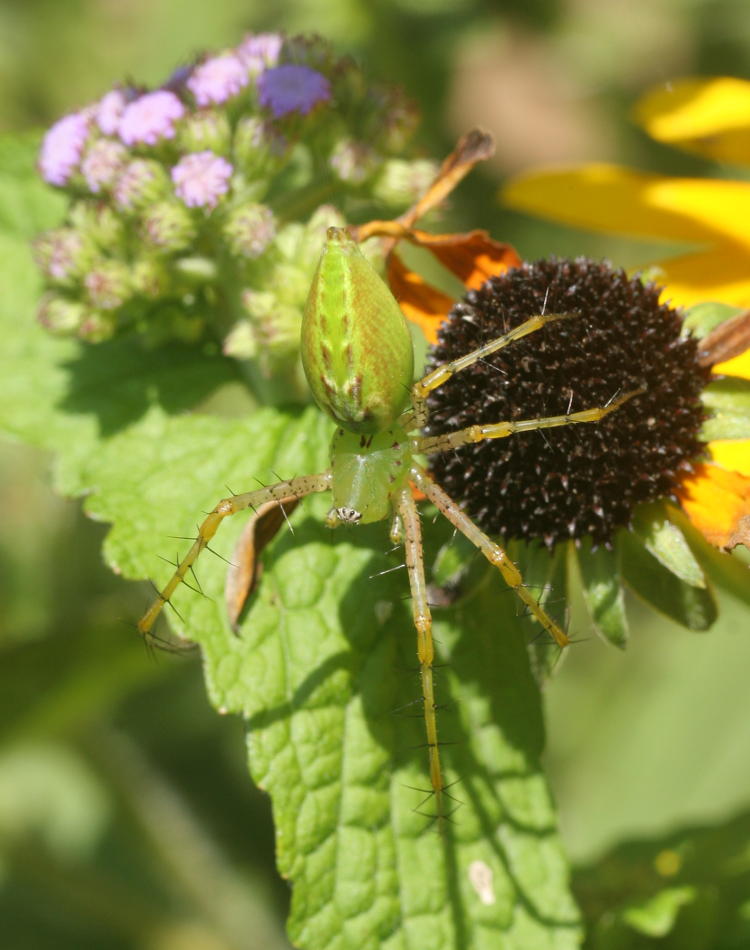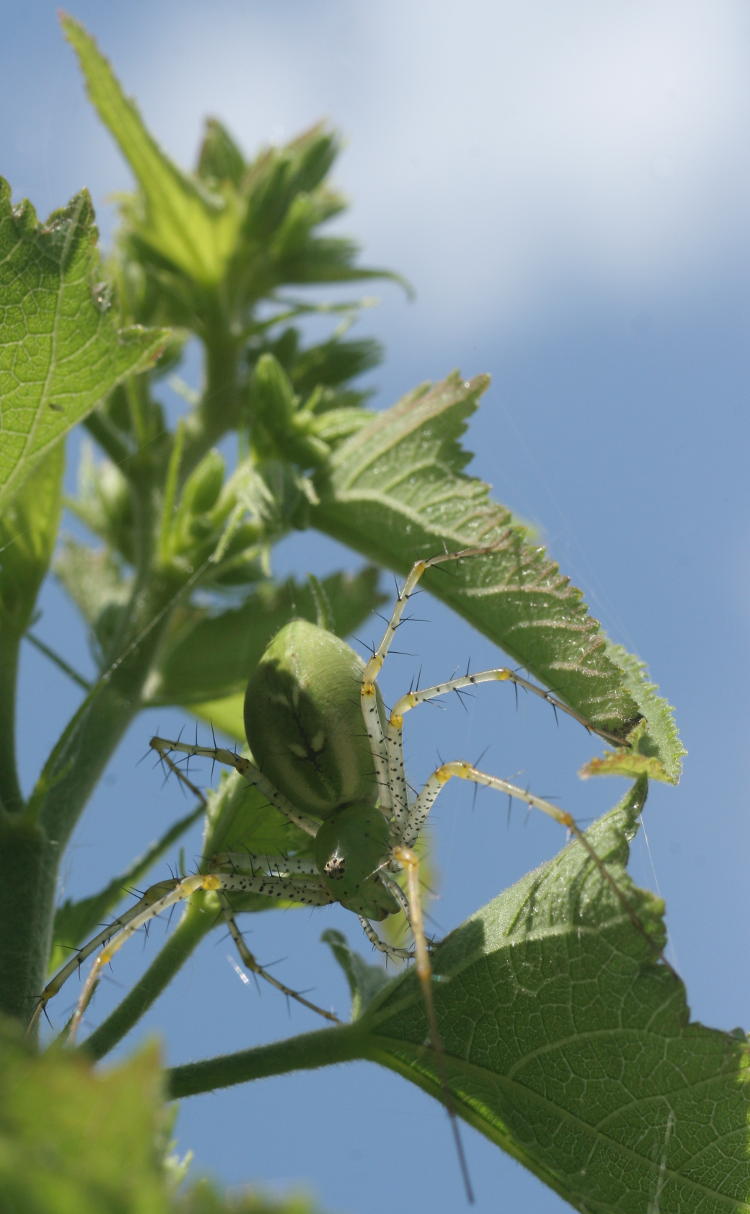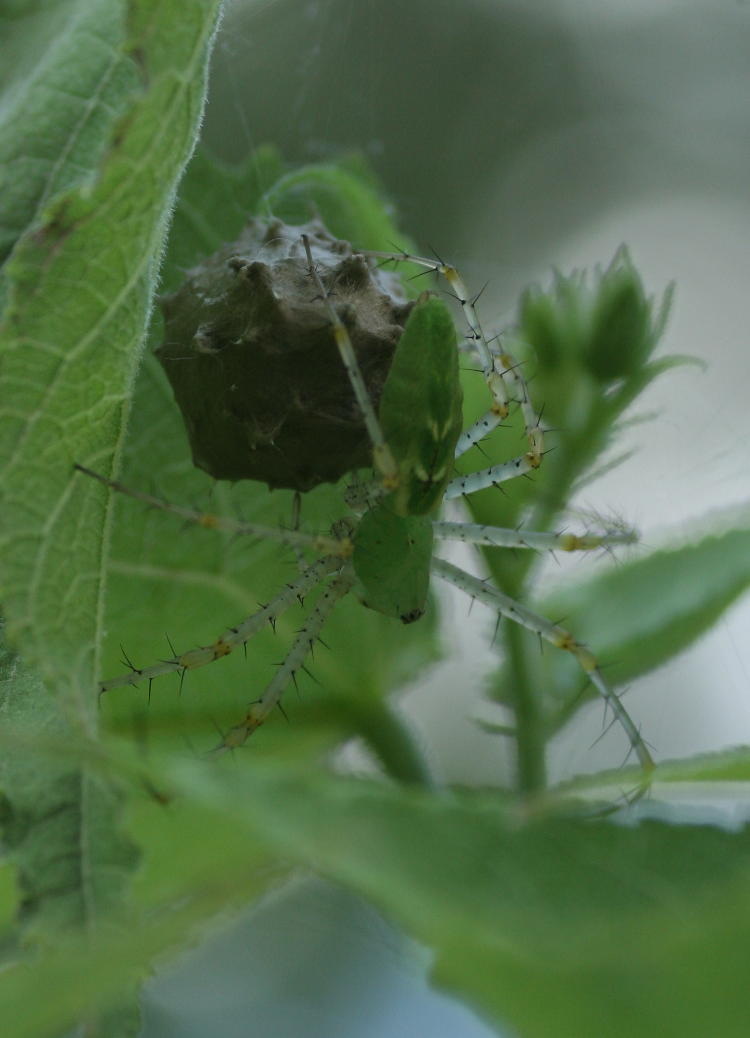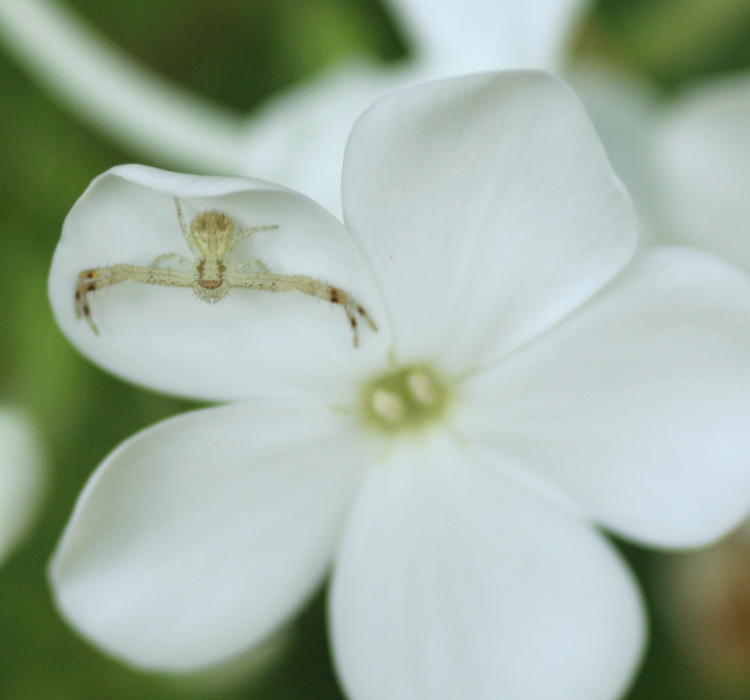I can only guess that entomologists have a bigger lobbying body than I would have expected, because today has been named National Green Lynx Spider Day by the American Association of Let’s Make Every Damn Day a Holiday. While I find this a frivolous method of celebrating nothing at all, it is a national holiday and I accordingly have the day off, so far be it from me to shirk my patriotic duty. My friends frequently maintain that if there’s anything you can say about ol’ Al, it’s that he’s patriotic. And honest too.
Luckily enough, I have a few relatively recent photos of green lynx spiders (otherwise known as Peucetia viridans,) so this is not a stretch. Yes, I know I said something about beach pictures, but there’s a proper time and place for things, and they’ll have to wait.

Green lynxes are ambush spiders, usually picking flowers with leaves that they blend in with well and hanging out until some stupid bug gets too close. Average size for the females is just under 30mm body length – decent-sized but not huge. At this time of year we’ve hit breeding season, which means fatter ones like that seen above are likely females about to produce an egg case, while thinner ones have either done so already (in which case ahaha you’ll see it very close by) or they’re males. They can certainly spin webs – most spiders can, regardless of their hunting technique – but generally any coordinated effort is for a nursery to protect the newborn young.
 We’ll go in close for a second to see a detail that I missed at the time, but found in editing. You’re seeing the tip of the abdomen here, with the spinnerets and a pair of draglines that most spiders maintain, a constant safety harness that allows them to drop away from predators or hazards without losing their place, as it were; is some cases they also serve as invisible tripwires, little warning signals that something possibly-edible is blundering around nearby, but I can’t say for sure if the lynx spiders use them that way or not. Even in bright sunlight they can be near-impossible to spot, but go out early on a humid morning when the temperature has dropped below the dewpoint and you’ll see just how many spiders there might be in any given area, since the webbing collects dew and thus becomes visible. Seriously, you’ll probably find a buttload (ahaha) of webs everywhere.
We’ll go in close for a second to see a detail that I missed at the time, but found in editing. You’re seeing the tip of the abdomen here, with the spinnerets and a pair of draglines that most spiders maintain, a constant safety harness that allows them to drop away from predators or hazards without losing their place, as it were; is some cases they also serve as invisible tripwires, little warning signals that something possibly-edible is blundering around nearby, but I can’t say for sure if the lynx spiders use them that way or not. Even in bright sunlight they can be near-impossible to spot, but go out early on a humid morning when the temperature has dropped below the dewpoint and you’ll see just how many spiders there might be in any given area, since the webbing collects dew and thus becomes visible. Seriously, you’ll probably find a buttload (ahaha) of webs everywhere.
By the way, as I fill up a little space alongside this image before moving on to the next, the webs of the two species of black widow spiders in the US are very strong, almost feeling like wire, and I’ve found them twice in this manner – the resistance as I put my hand against the strands was distinctly noticeable. Thankfully they don’t feel the need to rush out and bite everything that disturbs their webs.

From her swollen abdomen and the fact that she’s not in position near something that would attract her food, I’m speculating that this one is not far from producing her egg case, but I have yet to capture this in progress, from any species really (except a snail.) I have no idea when it typically occurs, though ‘overnight’ is a wild guess, nor how long it takes; I really need to stake out an expecting mum and watch for it, but we have none close enough to maintain such a vigil – I haven’t seen one in the yard. The images here were taken either in the NC Botanical Garden or at Gold Park.

And this is one with her egg case; you can see how much girth she’s lost after producing it. This is not the same spider, but was shot in the same location on the same day, not two meters from the other, but the sun had gone behind a cloud when I tackled this one. I’m not sure what makes for the bumpy/spikey appearance of the case, but it might simply be from the anchoring web strands. In my experience, the egg cases are pale green for the first day or so after being made, then turn a dead-leaf brown and remain that way. It will be several weeks before the young hatch, and the mother will hang around on the case or nearby the entire time, and run interference for the young for a while after hatching.

Now, I’m not exactly sure what I captured here, but I have strong suspicions that it’s a courtship in progress, with the male at top; he was definitely monkeying around near the back of the female, and looks to me here like he’s gathering in webbing that she’s producing. There are a couple of things that make me pause, however. The first is, she appears to be already well along the path to motherhood (though I know you should never assume, much less mention, anything of the sort,) so if I’m correct he’s late to the party. But she made no moves to chase him off either, or eat him or hit him with a frying pan or call HR. Secondly, the reproductive organs of the female are not located anywhere near that spot, but well underneath the spider just aft of the thorax, close to the legs (well, duh.) It is, in fact, the dark spot seen on her underside below as I went around to the sunny side, which made the exposure better but hid too much of the behavior.

The male spent some time finagling around up there, but never engaged in anything resembling copulation, possibly because he never received any receptive signals from the female – I dunno. It’s another thing that I should have captured on video, but it’s not as easy as simply saying that. Focus is wildly variable at macro magnification, requiring a steady subject and camera, and the position that I was in to capture these, slightly above my head on a tall flowering plant, was already awkward; a tripod would have been out of the question, and the breeze was swaying the plant back and forth too much to maintain focus. There are better conditions to pursue such things within.
I close with a not-green-lynx-spider, but an unidentified crab spider, genus Thomisidae, because I’m a rebel. During the same session in the botanical garden, I finally managed to spot a crab spider after much searching; the area is often ideal for them, but this year hasn’t been indicative of that at all. This one is tiny, only millimeters across, and I have several frames where focus was off, mostly from my own swaying. No, this is not unprofessional unsteadiness, but a purposeful motion like praying mantids use to appear like a plant in the breeze and disguise my true nature. So there.





















































